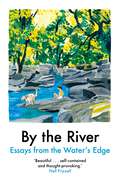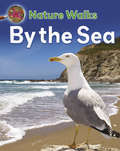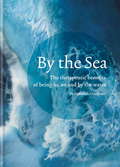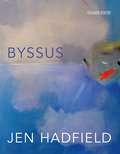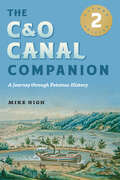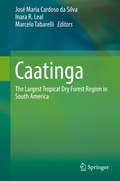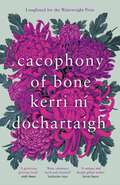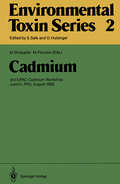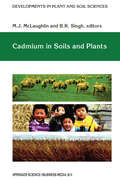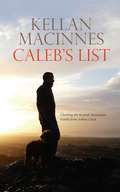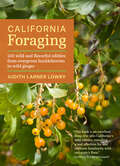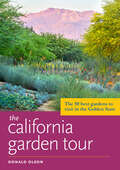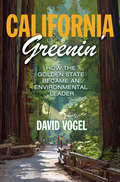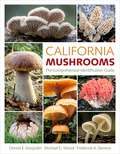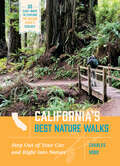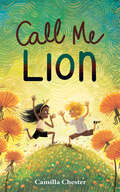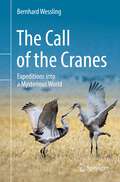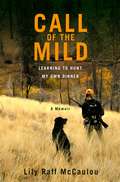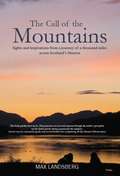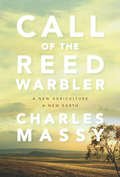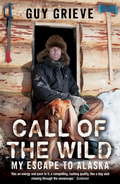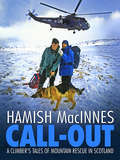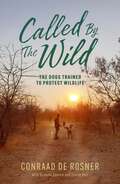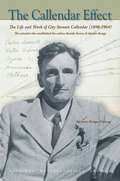- Table View
- List View
By the River: Essays from the Water's Edge
by Various ContributorsMemory flows like a river, and it is through its constant flow that we come into being. Twelve of our most exciting contemporary writers consider the subject of rivers and how they shape us throughout our lives, demarcating cities as well as moulding our creative consciousness. Tessa Hadley revisits Rumer Godden's The River; Jo Hamya pays homage to Virginia Woolf; Michael Malay goes nightfishing for eels along the River Severn; Marchelle Farrell revisits the tropical waterfalls of her childhood home in Trinidad; and Caleb Azumah Nelson is drawn to the Guadalquivir in Seville. Tender and astute, By the River explores the cultural, social and psychological significance of the rivers that run through our societies and our minds, bringing together writers in a celebration of water and its transformative qualities.
By the Sea (Nature Walks #2)
by Clare CollinsonTake a nature walk by the sea and become a nature detective to discover the different animals and plants that live there.
By the Sea: The therapeutic benefits of being in, on and by the water
by Dr Deborah CracknellIn this stunning book, intuition and instinct meet modern science as the therapeutic benefits of being in, on or by the sea are explained and explored, and how, if we look after the oceans they will, in turn, look after us. There is something about the vastness of the oceans, which are significantly larger than the continents combined, that has drawn humans in a significant way since the beginning of coastal communities. Throughout history, people have gravitated to live near the sea, it is part of the survival instinct. Water also has huge cultural and spiritual significance for people through the ages and for centuries we looked to the sand and surf as a fully-stocked medicine cabinet. Despite the widespread intuitive feeling that being by the water makes us happier and healthier, there hasn't been much scientific evidence to quantify this connection. Until now. Environmental psychology is the study of how the natural environment makes us feel, think and behave, and scientists in this area are discovering the tangible benefits of breathing in the fresh sea air.Reasons to spend time by the sea:1. Just looking at the sea can promote reductions in heart rate and improvements in mood.2. The negative ions in sea air accelerate your ability to absorb oxygen, and balance your seratonin levels.3. The bracing climate is especially beneficial to the respiratory organs and the skin, and also improves circulation and strengthens the body's defences.4. Spending time by the sea promotes better mental health.5. When you are by the sea you are more likely to exercise.
Byssus
by Jen HadfieldByssus is Jen Hadfield's third collection, and her first after the T.S. Eliot prize-winning Nigh-No-Place. Byssus - pronounced 'bissus', and meaning the mussel's 'beard', the tough fibres which anchor it to the seabed - is a book first and foremost about home, and what it takes to find and forge one: amongst friends, alert to mortality, to love and to landscape. Her language, strongly rooted in the common names she finds in the sea, shore and moor of her adopted Shetland, has already been widely admired for its startling originality. Here, through poems of astonishment and adoration, through charms and fables, and ultimately through a practice of attention and careful honouring - she shows how speech itself can be an act of home-making. Byssus is a profound consideration of just what it means to get to know a place.
The C&O Canal Companion: A Journey through Potomac History
by Mike HighA comprehensive guide to one of America's unique national parks, The C&O Canal Companion takes readers on a mile-by-mile, lock-by-lock tour of the 184-mile Potomac River waterway and towpath that stretches from Washington, D.C., to Cumberland, Maryland, and the Allegheny Mountains. Making extensive use of records at the National Archives and the C&O Canal Park Headquarters, Mike High demonstrates how events and places along the canal relate to the history of the nation, from Civil War battles and river crossings to the frontier forts guarding the route to the West. Using attractive photographs and drawings, he introduces park visitors to the hidden history along the canal and provides practical advice on cycling, paddling, and hiking�all the information needed to fully enjoy the park's varied delights. Thoroughly overhauled and expanded, the second edition of this popular, fact-packed book features updated maps and photographs, as well as the latest information on lodgings and other facilities for hikers, bikers, and campers on weekend excursions or extended outdoor vacations. It also delves deeper into the history of the upland region, relaying new narratives about Native American settlements, the European explorers and traders who were among the first settlers, and the lives of slaves and free blacks who lived along or escaped slavery via the canal.Visitors to the C&O Canal who are interested in exploring natural wonders while tracing the routes of pioneers and engineers�not to mention the path of George Washington, who explored the Potomac route to the West as a young man and later laid out the first canals to make the river navigable�will find this guide indispensable.
Caatinga: The Largest Tropical Dry Forest Region in South America
by José Maria Silva Inara R. Leal Marcelo TabarelliThis book provides in-depth information on Caatinga’s geographical boundaries and ecological systems, including plants, insects, fishes, amphibians, reptiles, birds, and mammals. It also discusses the major threats to the region’s socio-ecological systems and includes chapters on climate change and fast and large-scale land-use changes, as well as slow and small-scale changes, also known as chronic human disturbances. Subsequent chapters address sustainable agriculture, conservation systems, and sustainable development. Lastly, the book proposes 10 major actions that could enable the transformation of Caatinga into a place where people and nature can thrive together. “I consider this book an excellent example of how scientists worldwide can mobilize their efforts to propose sound solutions for one of the biggest challenges of modern times, i.e., how to protect the world’s natural ecosystems while improving human well-being. I am sure this book will inspire more research and conservation action in the region and perhaps encourage other groups of scientists to produce similar syntheses about their regions.” Russell Mittermeier, Ph.D. Executive Vice-Chair, Conservation International
Cacophony of Bone
by Kerri ni DochartaighLONGLISTED FOR THE WAINWRIGHT PRIZE FOR NATURE WRITING A WATERSTONES BEST BOOK OF 2023: NATURE AND TRAVEL When Kerri and her partner M moved to a small, remote railway cottage in the heart of Ireland they were looking for a home, somewhere to stay put. What followed was a year unlike any other. Cacophony of Bone maps the circle of that year – a journey from one place to another, field notes of a life – from one winter to the next. It is a telling of a changed life, in a changed world – and it is about all that does not change. All that which simply keeps on – living and breathing, nesting and dying – in spite of it all. This is an ode to a year, a place, and a love, that changed a life.
Cadmium: 3rd IUPAC Cadmium Workshop Juelich, FRG, August 1985 (Environmental Toxin Series #2)
by M. Piscator M. StoepplerOn May 25,1978, the Commission on Toxicology ofthe Division of Clinical Chemistry of the International Union of Pure and Applied Chemistry (IUPAC) established its Subcommittee on Environmental and Occupational Toxicology of Cadmium following aseries of Commission meetings in Kristiansand, Norway. I was appointed chairman ofthe new Subcommittee by the Commission on Toxicology (chairman at that time F. w. Sun derman Jr. ) in which I served from 1977 as an Associate Member and from 1979 as a Titular Member. From the beginning the Cadmium Subcommittee aimed not only at bringing together cadmium experts from around the world for scientific discussions but also at assessing, improving and the harmonization of analysis of cadmium. Due to the membership of many laboratories of the world engaged in scientific and analytical work on cadmium, and following some preliminary studies in a few laboratories from Sweden, The Netherlands and the Federal Republic of Germany, the Cadmium Subcommittee conducted from 1979 to 1985 four international interlaboratory surveys on cadmium analysis in body fluids. Two studies have been performed for cadmium in human and lyophilized bovine blood (1979 to 1980 and 1981) and another two for cadmium in artificial and human urines (1983 and 1985). At present in collaboration with the Selenium Subcommittee and the Subcommittee on Harmonization of Methods, a 5th survey for cadmium, lead and mercury in lyophilized human blood and serum reference materials is con ducted.
Cadmium in Soils and Plants (Developments in Plant and Soil Sciences #85)
by M. J. McLaughlin B. R. SinghOver forty years ago, concern was first focussed on cadmium contamination of soils, fertilisers and the food chain. Adverse effects on human health were first highlighted nearly 30 years ago in Japan with the outbreak of Itai-itai disease. Since then, substantial research data have accumulated for cadmium on chemistry in soils, additions to soils, uptake by plants, adverse effects on the soil biota and transfer through the food chain. However, this information has never been compiled into a single volume. This was the stimulus for the Kevin G. Tiller Memorial Symposium "Cadmium in Soils, Plants and the Food Chain", held at the University of California, Berkeley, in June 1997 as part of the Fourth International Conference on the Biogeochemistry of Trace Elements. This symposium brought together leading scientists in the field of cadmium behaviour in soils and plants, to review the scientific data in the literature and highlight gaps in our current knowledge of the subject. This series of review papers are presented here and deal with the chemistry of cadmium in soils, the potential for transfer through the food chain and management to minimise this problem. We hope this information provides a sound scientific basis to assist development of policies and regulations for controlling cadmium in the soil environment.
Caleb's List: Climbing the Scottish Mountains Visible from Arthur's Seat
by Kellan MacInnesShortlisted for the 2013 Saltire Society Scottish First Book award. Edinburgh. 1898. On the cusp of the modern age. Caleb George Cash: mountaineer, geographer, antiquarian and teacher stands at the rocky summit of Arthur's Seat. This is the story of Caleb, me and the Scottish mountains visible from Arthur's Seat. Somehow the Cashs or the Calebs didn't sound right so I have called the hills on Caleb's list The Arthurs. More than just a climbing book this is the story of a survivor. Caleb's List is a beautifully descriptive account in which Kellan MacInnes intertwines his own personal struggle with HIV with the life story of Victorian mountaineer Caleb George Cash, beginning with the moment in 1898 when Caleb stood at the top of Arthur's Seat in Edinburgh and made a list of 20 mountains visible from its summit, from Ben Lomond in the west to Lochnager in the east. MacInnes stumbled upon this long forgotten list of hills, now dubbed the Arthurs, and in this book he sets a new hillwalking challenge … climbing the Arthurs. Drawing on history, literature and personal experience, MacInnes offers both practical and emotional insight into climbing these hills, in an account that is a must-read for hillwalkers, visitors to Edinburgh and lovers of Scotland all over the world. This is not just a book about hillwalking and history. At its heart this is powerful landscape writing that explores the strong bond between a person and the hills they love . . . The author writes with skill and considerable authority. ALEX RODDIE, author Caleb Cash himself is an important if neglected figure in the history of the Scottish outdoors and the author's personal story gives the book an emotional power unusual in a guidebook. An excellent book. CHRIS TOWNSHEND, author A triumphant debut. THE GREAT OUTDOORS A tribute to the healing power of the Scottish landscape and to survival against the odds. THE SCOTSMAN
California Foraging: 120 Wild and Flavorful Edibles from Evergreen Huckleberries to Wild Ginger (Regional Foraging Series)
by Judith Larner Lowry&“This book is an excellent deep dive into California&’s wild edibles, revealing a real affection for and intimate familiarity with our state&’s flora.&” —Iso Rabins, founder of ForageSF California offers a veritable feast for foragers, and with Judith Larner Lowry as your trusted guide you will learn how to safely find and identify an abundance of delicious wild plants. The plant profiles in California Foraging include clear, color photographs, identification tips, guidance on how to ethically harvest, and suggestions for eating and preserving. A handy seasonal planner details which plants are available during every season. Thorough, comprehensive, and safe, this is a must-have for foragers in the Golden State.
The California Garden Tour: The 50 Best Gardens to Visit in the Golden State
by Donald OlsonIn The California Garden Tour veteran travel writer Donald Olson brings his style, wit, and insight to the public gardens of the Golden State. You'll discover the 50 most beautiful and iconic gardens to visit all across the state.
California Greenin': How the Golden State Became an Environmental Leader (Princeton Studies in American Politics: Historical, International, and Comparative Perspectives #157)
by David VogelA political history of environmental policy and regulation in California, from the Gold Rush to the presentOver the course of its 150-year history, California has successfully protected its scenic wilderness areas, restricted coastal oil drilling, regulated automobile emissions, preserved coastal access, improved energy efficiency, and, most recently, addressed global climate change. How has this state, more than any other, enacted so many innovative and stringent environmental regulations over such a long period of time? The first comprehensive look at California's history of environmental leadership, California Greenin' shows why the Golden State has been at the forefront in setting new environmental standards, often leading the rest of the nation.From the establishment of Yosemite, America's first protected wilderness, and the prohibition of dumping gold-mining debris in the nineteenth century to sweeping climate- change legislation in the twenty-first, David Vogel traces California's remarkable environmental policy trajectory. He explains that this pathbreaking role developed because California had more to lose from environmental deterioration and more to gain from preserving its stunning natural geography. As a result, citizens and civic groups effectively mobilized to protect and restore their state's natural beauty and, importantly, were often backed both by business interests and bystrong regulatory authorities. Business support for environmental regulation in California reveals that strict standards are not only compatible with economic growth but can also contribute to it. Vogel also examines areas where California has fallen short, particularly in water management and the state's dependence on automobile transportation. As environmental policy debates continue to grow more heated, California Greenin' demonstrates that the Golden State's impressive record of environmental accomplishments holds lessons not just for the country but for the world.
California Greenin': How the Golden State Became an Environmental Leader (Princeton Studies in American Politics: Historical, International, and Comparative Perspectives #157)
by David VogelA political history of environmental policy and regulation in California, from the Gold Rush to the presentOver the course of its 150-year history, California has successfully protected its scenic wilderness areas, restricted coastal oil drilling, regulated automobile emissions, preserved coastal access, improved energy efficiency, and, most recently, addressed global climate change. How has this state, more than any other, enacted so many innovative and stringent environmental regulations over such a long period of time? The first comprehensive look at California's history of environmental leadership, California Greenin' shows why the Golden State has been at the forefront in setting new environmental standards, often leading the rest of the nation.From the establishment of Yosemite, America's first protected wilderness, and the prohibition of dumping gold-mining debris in the nineteenth century to sweeping climate- change legislation in the twenty-first, David Vogel traces California's remarkable environmental policy trajectory. He explains that this pathbreaking role developed because California had more to lose from environmental deterioration and more to gain from preserving its stunning natural geography. As a result, citizens and civic groups effectively mobilized to protect and restore their state's natural beauty and, importantly, were often backed both by business interests and bystrong regulatory authorities. Business support for environmental regulation in California reveals that strict standards are not only compatible with economic growth but can also contribute to it. Vogel also examines areas where California has fallen short, particularly in water management and the state's dependence on automobile transportation. As environmental policy debates continue to grow more heated, California Greenin' demonstrates that the Golden State's impressive record of environmental accomplishments holds lessons not just for the country but for the world.
California Mushrooms: The Comprehensive Identification Guide
by Dennis E. Desjardin Michael G. Wood Frederick A. StevensCalifornia Mushrooms is a comprehensive guide, providing information on when and where to find mushrooms; guidelines on how to collect and identify mushrooms; keys to species; and overviews of nomenclature and taxonomy, morphology and phylogeny, fungal ecology, biology, and mushroom toxins.
California's Best Nature Walks: 32 Easy Ways to Explore the Golden State's Ecology
by Charles HoodExplore some of California&’s most exquisite landscapes with this accessible hiking guidebook featuring descriptions of the flora, fauna, and ecology hikers will discover along the trail. See the oldest trees in the world—and the tallest. Meet earthquake-loving fish, lively island foxes, and endemic birds. Visit the saltwater homes to sea otters and a desert basin where the water is even saltier. In California&’s Best Nature Walks, Charles Hood reveals the golden state&’s unique ecosystems, guiding you through 32 spectacular natural areas, with advice on deciphering the terrain. All are within easy walking distance of the road. This is an essential companion for road-trippers, outdoor enthusiasts, and day hikers—no cleated boots or trekking poles necessary. Locations include the Arcata Marsh and Wildlife Sanctuary, McConnell Arboretum and Botanical Gardens, Olmsted Point at Yosemite National Park, Fossil Falls, Camp Roberts Rest Area along Highway 101, Scorpion Anchorage at Channel Islands National Park, Vasquez Rocks Natural Area, and more!
Call Me Lion
by Camilla ChesterTen-year-old Leo dreams of performing in the West End. His love of dancing is getting him through the Luton heatwave, but his selective mutism is putting his spot in the end-of-summer dance show on the line.When chatty Richa moves in next door, Leo finds it easy to bond with her. She talks enough for the both of them ... at least to begin with. But when he learns her secret it's clear that Richa needs Leo's support as much as he needs hers.With Richa's help, will Leo be able to follow his dreams? Or will Leo's inability to talk cost him their friendship?A heart-warming story of courage and determination in the face of adversity, perfect for fans of Jacqueline Wilson, Lisa Thompson, Stewart Foster and Elle McNicoll.
The Call of the Cranes: Expeditions into a Mysterious World
by Bernhard WesslingCranes are enigmatic birds. Only very little is known about the behaviour of these graceful dancers. The renowned naturalist and crane expert Bernhard Wessling takes us on exciting and adventurous expeditions into their hidden world and gets to the bottom of the myths surrounding these birds of happiness. With the help of a specially developed bioacoustic method, Dr. Wessling studied Eurasian, Red-Crowned, Sandhill and Whooping Cranes, all in the wild. He has researched their intelligence, social dynamics and communication and engaged in their protection. Impressively illustrated and lively narrated, this book presents his findings on their individually unique lives and relationships, their ability to adapt and solve problems, and their emotions. His observations allow us to delve deeply into the cranes' way of life and consciousness, often demonstrating the surprising similarities between humans and animals. An amazing work about the spirit of discovery, humility and respect for nature in the tradition of Alexander von Humboldt.Cranes are among the most captivating birds on this planet. Dr. Wessling knows these birds, has accumulated a lifetime of observations on them, and has thought deeply about their abilities. In this book, he seeks to overturn old ideas about how these birds live, communicate, and think. His revelations surprise and delight and shed new light on an ancient avian family. Jennifer Ackerman, author of the New York Times bestseller The Genius of Birds and The Bird WayThe Call of the Cranes is a mesmerizing, vivid, lyrical and revelatory book. It truly is a spectacular book and a treasure! Sy Montgomery, naturalist and author of 31 books (incl. the New York Times bestseller The Soul of an Octopus: A Surprising Exploration into the Wonder of Consciousness)In this book, Bernhard Wessling shares his fascinating stories about cranes through patient observations and thoughtful conclusions. George Archibald, Co-Founder of the International Crane Foundation, Senior Conservationist
Call of the Mild: Learning to Hunt My Own Dinner
by Lily Raff McCaulouWhen Lily Raff McCaulou traded in an indie film production career in New York for a reporting job in central Oregon, she never imagined that she'd find herself picking up a gun and learning to hunt. She'd been raised as a gun-fearing environmentalist and an animal lover, and though a meat-eater, she'd always abided by the principle that harming animals is wrong. But Raff McCaulou's perspective shifted when she began spending weekends fly-fishing and weekdays interviewing hunters for her articles, realizing that many of them were more thoughtful about animals and the environment than she was. So she embarked upon the project of learning to hunt from square one. From attending a Hunter Safety course designed for children to field dressing an elk and serving it for dinner, she explores the sport of hunting and all it entails, and tackles the big questions surrounding one of the most misunderstood American practices and pastimes. Not just a personal memoir, this book also explores the role of the hunter in the twenty-first century, the tension (at times artificial) between hunters and environmentalists, and new models of sustainable and ethical food procurement.
The Call of the Mountains: Sights and Inspirations from a journey of a thousad miles across Scotland's Munro ranges
by Max LandsbergAn adventure across a thousand miles of Scotland's mountains. In this personal guide to the triumphs, hardships and perils of scaling the Munros, Landsberg brings the joys and pitfalls of hill-climbing to life. Landsberg's adventures are presented in vivid detail, with insights ranging from encompassing the wonder of unique experiences like seeing the birth of a deer to the mundane delight of the flavour of sandwich he had on a given day. Throughout his account, Landsberg provides an in-depth insight into his growing obsession with climbing the Munroes and its effect on his physical, emotional and spiritual development. With insights on the history, culture, ecology and geology of Scotland's mountains and guides to Gaelic place names, mountain safety and an analysis the science of walking, this book provides a complete guide for anyone looking for adventure in the Highlands, and is sure to inspire anyone who reads it to go climb a rock! Excerpt: One day I walked into these mountains, and I never came all the way back. For though Scotland's mountains may not be the highest in the world, they are certainly amongst the most awe-inspiring and enchanting. From the towering pinnacles of Skye, to the high rolling plateau of the Cairngorms; from the bonnie braes of Ben Lomond to the weeping cliffs of Glencoe; from the rocky battlements that encircle Loch Arkaig, to the gentle folds of Ben Lawers as it spills down to Loch Tay: here are offered scenes of unrivalled splendour, landscapes of unparalleled variety, and a magic ground for personal connection, inspiration, and transformation. These are places of accessible adventure - we leave behind the safety of the lush glen to cross the swooping moor, clamber up through craggy corridors, and with silver chuckling burn then spatey cascade as our sometime guide we reach at last the grand summits of these lands. Here beneath a hundred rainbows lie a hundred pots of gold - unclaimed scenic ingots that are yours for the taking and to which I hope to lead you, on a journey for body, for mind, and perhaps for something deeper.
Call of the Reed Warbler: A New Agriculture, A New Earth
by Charles Massy Nicolette Hahn NimanIn Call of the Reed Warbler, Charles Massy explores regenerative agriculture and the vital connection between our soil and our health. It is the story of how a grassroots revolution—a true underground insurgency—can save the planet, help reduce and reverse climate change, and build healthy people and healthy communities, pivoting significantly on our relationship with growing and consuming food. Using his personal experience as a touchstone—from an unknowing, chemical-using farmer with dead soils to a radical ecologist farmer carefully regenerating a 2000-hectare property to a state of natural health—Massy tells the real story behind industrial agriculture and the global profit-obsessed corporations driving it. With evocative stories, he shows how other innovative and courageous farmers are finding a new way. At stake is not only a revolution in human health and in our communities, but the very survival of the planet. For farmers, backyard gardeners, food buyers, health workers, policy makers, and public leaders alike, Call of the Reed Warbler offers a tangible path forward and a powerful and moving paean of hope. It’s not too late to regenerate the earth. Call of the Reed Warbler shows the way forward for the future of our food supply, our planet, and our health.
Call of the Wild: My Escape to Alaska
by Guy GrieveGuy Grieve's life was going nowhere - trapped in a job he hated, commuting 2,000 miles a month and up to his neck in debt. But he dreamed of escaping it all to live alone in one of the wildest, most remote places on earth - Alaska. And just when he'd given up hope, the dream came true. Suddenly Guy was thrown into one of the harshest environments in the world, miles from the nearest human being and armed with only the most basic equipment. And he soon found - whether building a log cabin from scratch, hunting, ice fishing or of course dodging bears in the buff - that life in the wilderness was anything but easy...Part Ray Mears, part Bill Bryson, CALL OF THE WILD is the gripping story of how a mild-mannered commuter struggled with the elements - and himself - and eventually learned the ways of the wild.
Call-out: A climber's tales of mountain rescue in Scotland
by Hamish MacInnesCall-out is the definitive collection of tales about early mountain rescue in the Highlands of Scotland from Hamish MacInnes – Everest pioneer and arguably the most famous Scottish mountaineer of the twentieth century.In the late 1960s, MacInnes led the Glencoe Mountain Rescue team and together they developed innovative techniques and equipment in order to save lives – often risking their own in the process – whether night or day, and always at a moment’s notice. He was a central figure in the rescue during the 1963 New Year tragedy in the Cuillins on the Isle of Skye, and led groundbreaking rescues on Buichaille Etive Mor, Ben Nevis, Bidean nam Bian and many other legendary Scottish mountains.At the heart of the stories in Call-out are the unique characters in the team and wider Glencoe community who demonstrate faultless camaraderie, and – by virtue of MacInnes’s engaging storytelling – inject an almost comical slant into these sometimes-grim accounts of misadventure in the mountains.The dark allure of the frozen Scottish peaks provides a foreboding backdrop against which we learn of Hamish MacInnes’s concern for human life under even the most extreme conditions. Call-out offers an inspiring portrayal of responsible and dedicated mountaineering practice, which is as pertinent today as ever.
Called By The Wild: The Dogs Trained to Protect Wildlife
by Conrad De Rosner Elaine Bell Graham SpenceThe thrilling story of a pioneering conservationist working with dogs to protect wildlife from poachers. Conraad de Rosner is one of the first game rangers to focus on working with specially trained dogs to protect wildlife from poachers – both 'bushmeat' poachers, who use cruel snares to trap animals, and criminal syndicates killing for rhinoceros horn and capturing critically endangered pangolins, the most trafficked animal in the world. Con's life – constantly at risk from poachers, wildlife and even his own fellow rangers – has been saved on numerous occasions by his devoted canine companions. His first dog, Zingela, a Weimaraner, saved Con from near certain death at the hands of two fellow rangers; on another occasion, Zingela alerted Con to a concealed wounded buffalo, one of Africa's most dangerous animals, about to charge. When Zingela was tragically killed, hit by a car while Con was away, the only meagre consolation was that Con had kept Landa, one of the nine puppies sired by Zingela. Landa followed in his father's footsteps as the leader of the canine anti-poaching team that is still operating today. Con's story is an epic of modern-day African wildlife conservation, filled with courage, adventure and romance.
The Callendar Effect: The Life and Work of Guy Stewart Callendar (1898-1964)
by James FlemingGuy Stewart Callendar (1898–1964) is noted for identifying, in 1938, the link between the artifcial production of carbon dioxide and global warming. Today this is called the “Callendar Efect. ” He was one of Britain’s leading steam and combustion engineers, a specialist in infrared physics, author of the standard reference book on the properties of steam at high tempe- tures and pressures, and designer of the burners of the notable World War II airfeld fog dispersal system, FIDO. He was keenly interested in weather and climate, taking measurement so accurate that they were used to correct the ofcial temperature records of central England and collecting a series of worldwide weather data that showed an unprecedented warming trend in the frst four decades of the twentieth century. He formulated a coherent theory of infrared absorption and emission by trace gases, established the nineteenth-century background concentration of carbon dioxide, and - gued that its atmospheric concentration was rising due to human activities, which was causing the climate to warm. Callendar’s contributions to climatology led the way in the mid-twentie- century transition from the traditional practice of gathering descriptive c- mate statistics to the new and exciting feld of climate dynamics. In the frst half of the twentieth century, the carbon dioxide theory of climate change xiv Introduction had fallen out of favor with climatists.
